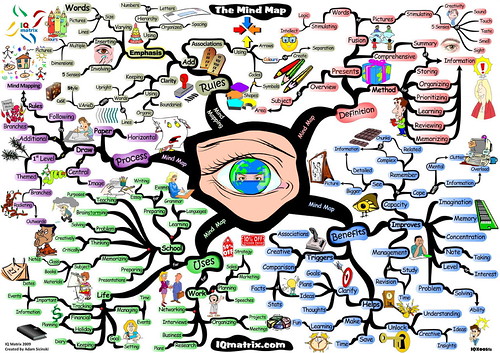Do you use mind maps? I don’t. Or at least, I didn’t, before a few weeks ago. I’d heard/read about other people who use them but I’ve never been that interested, I think partly because the examples I’ve always seen have looked kind of, well, messy, with circles and branches all over the place (the example I found for this post being a case in point!). So I associated mind maps with more creative, non-linear thinking. In contrast, I am very much a structured-outline kind of girl. Along those lines, I am also a huge maker of To Do lists, mostly organized the old-fashioned way: written on random bits of paper, kept together and loosely organized on a clipboard.
But a few weeks ago, I read an article that, for some reason, got me thinking that maybe I should give mind mapping a try. Even though the article contains one of those really messy mind map examples I find completely intimidating, I happened to read it when I was in the middle of going through all the different projects I’m working on and trying to find some way to get everything organized. My problem is that each project has its own To Do list, and although very few of the items are urgent (in the sense of ‘must get done by some deadline in the near future’), I know I need to make steady progress on each of them. I previously had kept a page on my clipboard where, for each project, I had my To Dos listed but a) as I crossed off items, it became harder to keep track of what still needed to get done, b) I would run out of space to add new items so I found myself re-doing the whole list every couple weeks, and c) I had a hard time keeping track of which projects needed my attention most. All of these issues suggested that I needed an electronic solution but I’ve tried many different task list applications and have never found anything that I felt worked well for me.
So I figured I’d see how a mind map app would work. I did some digging around for a cloud-based application because I want to be able to access my Task List map on my phone or tablet. I ended up trying Mindomo and pretty quickly made my first map. From the starting core, I added branches that represent the main areas of my work life (i.e., Teaching, Research, Department, Other) and then added branches from there for each project (e.g., below Teaching, I have a branch for each of my classes plus one for this blog and one for a workshop I’m developing for the San Diego Council for Economic Education). Below each project, I have branches for each To Do task.
In structure, this isn’t all that different from what I could do with an outline made in Word. But there are several things that are easy to do with Mindomo that mesh well with the way I think about my tasks:
- I can expand and collapse different branches, making it easy to focus on my tasks for a specific project or all the projects within a specific work area. I can expand the map so just the first and second levels are showing, which basically shows me a list of all my projects, or I can expand all the branches so looking at the outer-most ring gives me an idea of ALL the tasks I have for ALL my projects. Or say I want this to be a Research week, I can look at just the tasks related to my Research projects, or the tasks related to just one paper.
- I can move tasks from one branch to another easily. I have a ‘completed’ branch for each project so as I complete tasks, I move them to that branch and then keep that branch collapsed so I don’t see those tasks when I’m looking at what needs to still get done.
- I can add tasks anytime and anywhere, and I can re-order branches to visually reflect which projects and tasks I need to prioritize.
- The free version of Mindomo allows me to store three maps on their server (you can have unlimited maps on your local machine). So I can see all my tasks on my phone if I’m away from my computer (technically, I can also edit my cloud-based maps, which I might do if I were on a tablet but it’s a bit hard on a phone).

Mind mapping makes a great sense of humor in terms of task management. What ever features a task manager may be having the basic requirement for a better one always helps to go with the initial set up of the management which is the ultimate focus of the human mind who is gonna set up the management.
ReplyDeleteI use cloud based task management software (http://www.replicon.com/olp/task-management-software.aspx) which is the best option in the industry but still if at the initial stage the proper coordination is not worked out there is gonna be a complex situation in the suture aspects.